

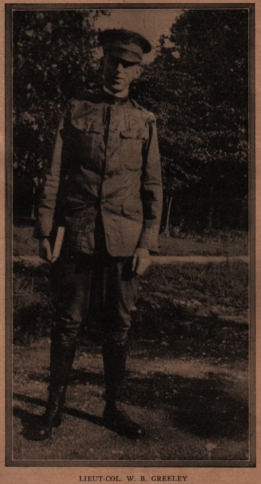
Nothing illustrates the far-reaching economic demands of the Great War more sharply than the enormous use of timber in almost every phase of military operations. From the plank roads at the front, the bomb proofs, the wire entanglements, and the ties needed for the rapid repair or construction of railroads upon which military strategy largely depended, to the hospitals, warehouses, camps, and docks at the base ports, timber was in constant demand as a munition of war. One of the earliest requests for help from the United States by both our French and British allies was for regiments of trained lumbermen. General Pershing had been in France less than two months when he cabled the War Department for a force of lumberjack soldiers large enough to cut upwards of 25,000,000 board feet per month for the American Expeditionary Force. A year later, the requirements of the enormous army then planned for and being sent to France with all possible speed were put at over 73,000,000 board feet per month.
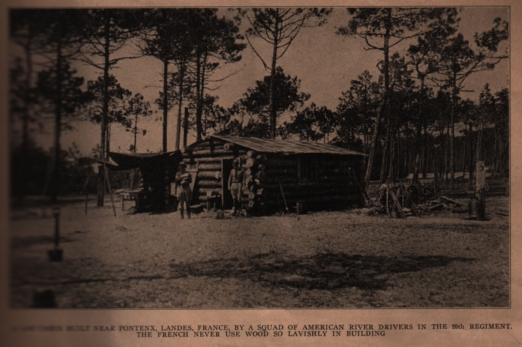
Such was the task marked out for the lumberjack regiments of the American Army, for the lack of ocean transport made it necessary to obtain practically all of this material from French forests. The organization of these lumberjack units, all of which were combined later in the 20th Engineers (Forestry), began in May, 1917, and continued until March, 1918. By May, 1918, forty-eight companies of forest and road engineers, each 250 men strong, had been sent to France. The core of a 49th Company was obtained subsequently from the New England sawmill units which were sent to old England in the early summer of 1917 to cut lumber for the British Government. These troops represented ever State in the Union. Practically every forestry agency in the country, together with many lumber companies and associations, took off their coats to help in obtaining the right type of men. The road engineers of the United States took hold of the organization of the twelve companies of troops designed for road construction in a similar spirit. The lumber units were officered largely by picked men of experience in forest industries of America; and the road units by road and construction engineers of exceptional technical ability.
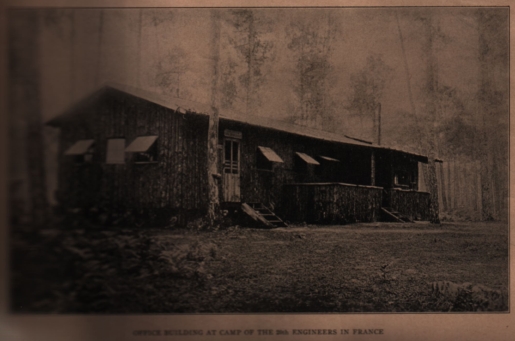
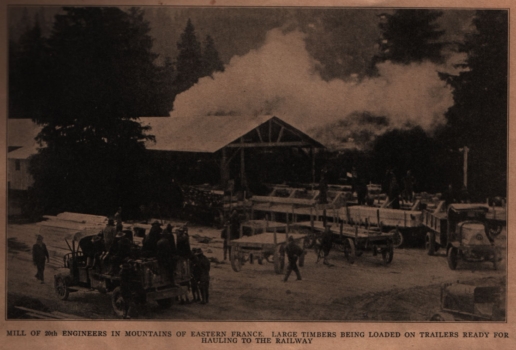
The earlier units were made up entirely from volunteer enlistments. The later units contained a large proportion of men from the draft, selected for forestry work mainly on the basis of their former occupations, together with many volunteers beyond the draft age from among the experienced loggers and sawmill mechanics of the country. But there was no distinction between volunteer or drafted soldiers in the way the American lumberjacks hit their job in France. These men represented the best of their hardy and resourceful profession in the United States. They came straight from her forests and sawmills, trained in here woodcraft, with all of the physical vigor, the adaptability to life in the open, and the rough and ready mechanical skill of the American woodsman. They knew their work and were ready to put all that they had into it.
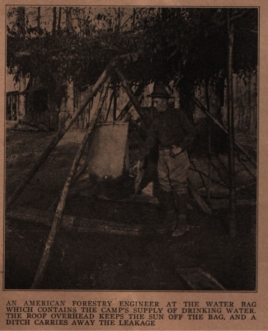
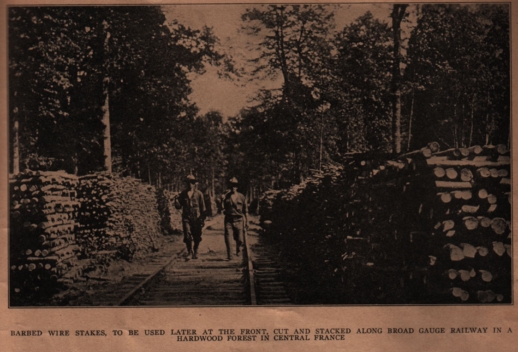
Furthermore, these lumberjack soldiers felt in a peculiar way that their country was behind them. This was not only in the focusing of national forces from every point upon winning the war, but in the special efforts of the forest industries to man and equip the lumber regiments. Many lumber companies had sacrificed their own interests in urging valued employees to join the ranks of the forest regiments. In many cases differences in pay were made good by old employers or provision made for the families left behind. And the lumberjack soldiers felt, too, the backing of friendliness and forethought which followed them to France, in the organized steps taken by the lumber and forestry associations for their comfort and welfare.
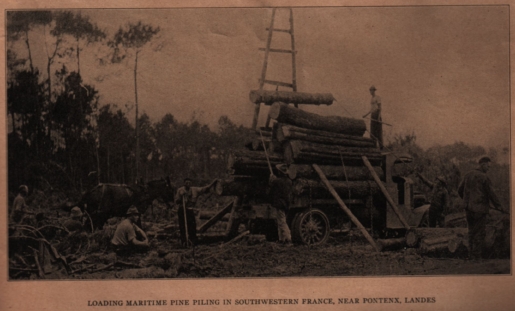
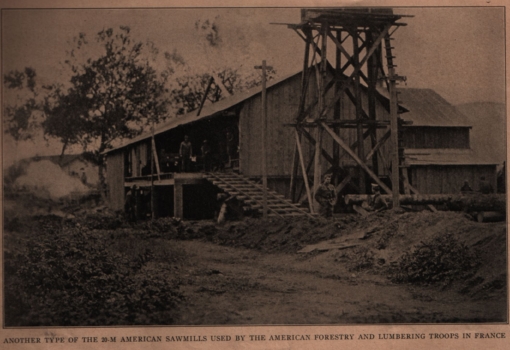
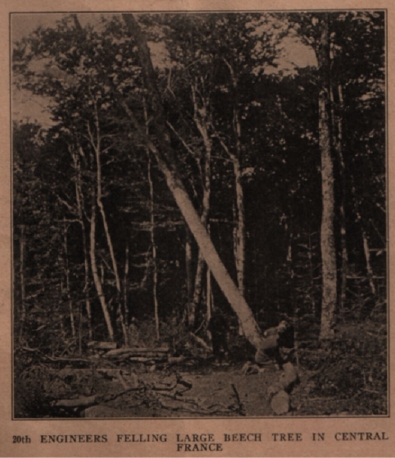
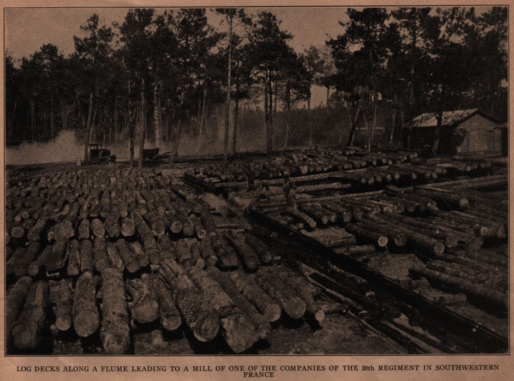
To meet the growing requirements of the American Army, Engineer Service battalions were rapidly added to the forestry and road troops during the summer and fall of 1918. At the end of hostilities, thirty-six Service companies were working with the 20th Engineers. The first four of them were white troops, organized as the 503d Engineers. The contained a large proportion of railroad men and other skilled workers, and were soon in the mills and woods and on railroad jobs, on all fours with the forestry troops. Upon the other Service Companies, composed of colored troops, fell the brunt of cutting the fuelwood which the Quartermaster was calling for by the hundreds of thousands of cords. But several sawmill crews composed largely or entirely of black soldiers made exceedingly creditable records.
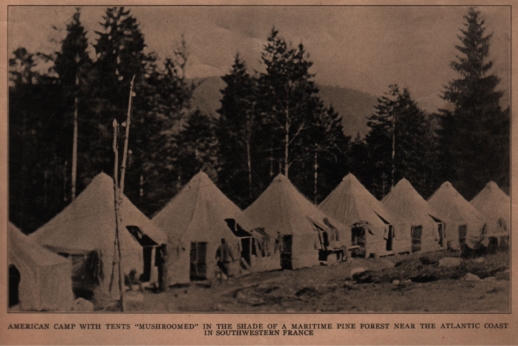
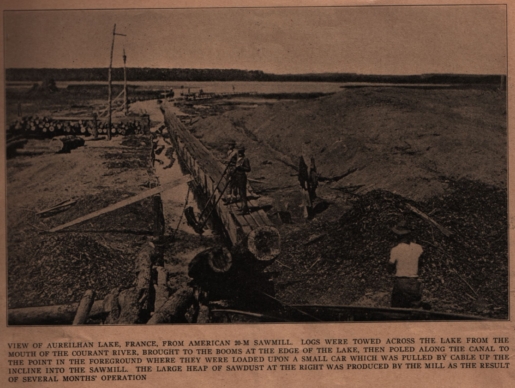
The first board was cut by the American troops in France, at a little French mill in the Jura Mountains, on November 26, 1917. The first American mill began sawing near Gien, on the Loire River, November 29, 1917. Still earlier, another company of the old 10th Engineers began cutting fifty-foot piling in the pine forests of the Landes, hauling them out of the woods on the running gear of army supply wagons, by man power. On the date when the armistice was signed, the 20th Engineers were operating eighty-one American sawmills in France and cutting 2,000,000 feet of lumber, ties, poles and piling every working day. One year after the first American saw bit into its first log in France and shrilled defiance at the Kaiser, the forestry troops of the American Expeditionary Forces had cut 300,000,000 board feet of lumber and ties, 38,000 piles, 2,878,000 poles of all sizes, and 317,000 cords of fuelwood. It is impossible, in a few words, to tell of the labor, the Yankee ingenuity, and the resolution to back up our fighting doughboys which were called for to win these results. Nor is it possible to describe the pressure upon all of us during the summer and fall of 1918 when every lumberjack in the regiment felt the tenseness of the final grapple and put everything he had into it.
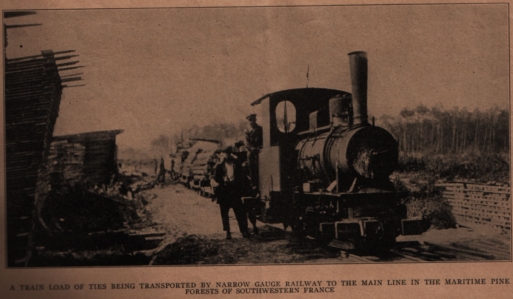
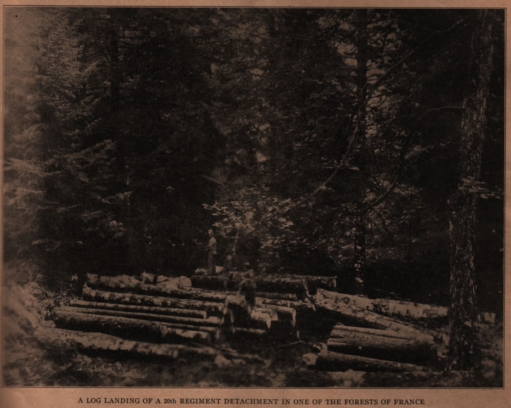
I will never forget the big mill at the Eclaron as I saw it one October night--sparks streaming from its stacks, its two carriages flashing back and forth, loads of oak logs creaking up to the mill deck, cars being shunted about, ties loaded into them hot from the saws, and the sober, earnest faces of the men as they worked under the electric lights. They were shipping 5,000 ties daily to the Argonne offensive. That scene was typical of the eighty or more forestry operations in France during the great drive. It is doubtful if American resourcefulness was ever put to a harder test than during the first months of the forestry work in France. One company of the 4th Battalion began skidding ties with harness made out of ropes and old sacks, and bridles fashioned from twenty-penny nails and wire. This "hay-wire" camp speedily made off with the monthly records of the section for tie production. During the long, anxious wait for the arrival of the American sawmills, French mills of various antique designs were utilized at many points. On his introduction to one of these, a millwright from the northwest offered to eat its daily cut. The French mills were aggravations of the flesh and promoters of profanity. They all had to be bolstered up, more or less rebuilt, have carriages devised out of any odd lots of machinery at hand, and new saws added. Poor as they were, they served to tide the army over its first few months in France, and their production under the "ancient regime" was doubled or trebled by the lumberjack soldiers.
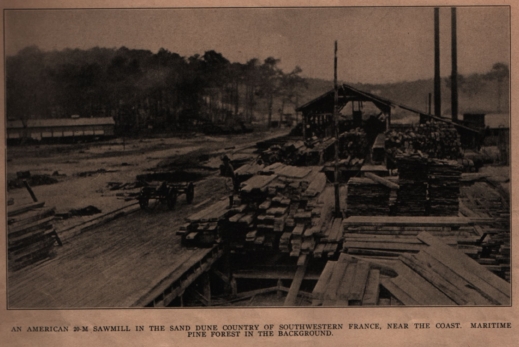
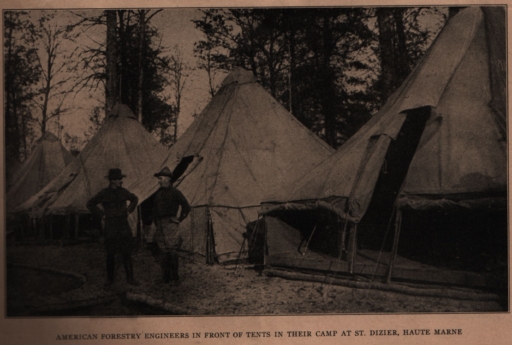
As the American mills were installed and production jumped month by month, fierce joy of rivalry seized the souls of the forest engineers. Time would fail to tell of the early contest between A and B Companies of the 10th Engineers, when records stood but a day or two and our "ten-thousand" mills showed up as twenty-five and thirty thousand a day producers. The largest day's cut at any forestry operation was turned out by the 27th Company at Mouthe, which in 23 hours and 35 minutes cut 177,486 board feet of fir lumber and timbers on a "twenty-thousand" mill. The largest twenty-hour cut, 163,376 feet, was made by the 37th Company (Old F Company of the 10th Engineers) at Levier with the same type of mill and product. The 26th Company at La Cluse holds the record for a twenty-hour run with a "ten-thousand" mill, 78,881 feet; close behind came the 24th Company with a record cut of 68,659 feet, the 30th with a cut of 63,849 feet, and the 49th Company at Murat, organized to build roads, with 63,000 feet. The 23d Company, at Marchenoir, holds the record for a twenty-hour cut with a "ten" mill in hardwoods, knocking out 55,539 feet. The 22d Company, at La Gavre, pushed its rival hard, however, with a twenty-hour cut of 49,416 feet of oak lumber and timbers. One of the best hardwood records is that of the 2nd Company, at Grande Mirebeau, which was determined to reach the million a month mark with a "ten" mill, and finally did so, in October, with a cut of 1,000,620 feet. One of the most remarkable achievements was that of the 19th Company, which in ten and one-half hours cut 64,047 feet of straight oak ties with a bolter mill rated at five thousand feet per day.
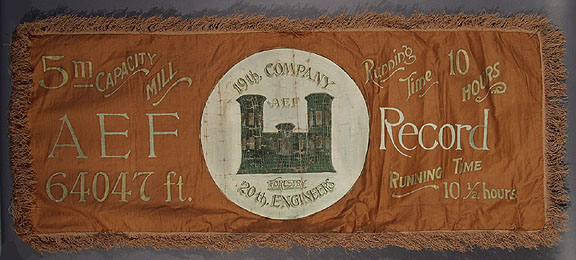
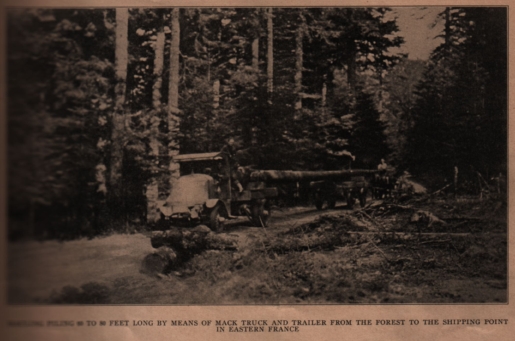
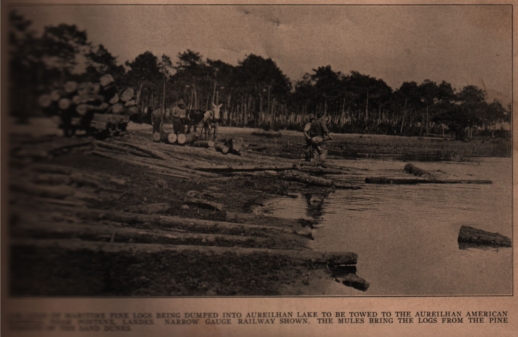
Small wonder that the American Lumberman has indicted the forest engineers of the American Expeditionary Forces for "cruelty to machinery." But the Hun wanted war--and, by the shades of the forest primeval, he should have it. It is difficult to stop in recording these instances of how the American lumberjack "tied into" their work in France. The 6th Battalion, working for the British Army at Castets, cut 124,242 feet in nineteen hours with a twenty-thousand Canadian sawmill, and 72,697 feet in twenty hours with a French band mill whose makers would have been aghast at such performances. The 13th Company, at Brinon, cut 1,361 pine logs on a "ten" mill in twenty hours, with a yield 53,895 feet of lumber. Many of the American "twenty" mills cut steadily upwards of 1,200,000 board feet per month, and several of them exceeded 1,200,000 board feet per month, and several of them exceeded 2,000,000 feet monthly on their best runs. The spirit of "hitting her hard" pervaded every camp. The 19th Service Company, at Collonges, not to be outdone by the chesty mill crews, organized a fuelwood contest in which 100 black soldiers aver aged 6.31 cubic meters of cut wood daily for a week.
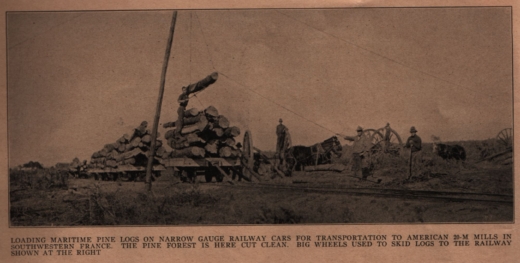
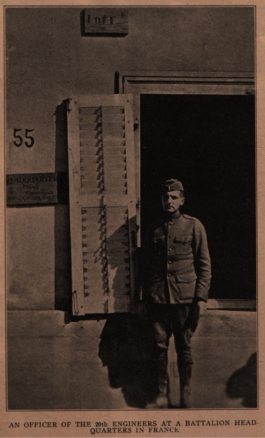
It is even rumored that a red-headed captain of the old Tenth, learning from his own spies that his monthly record was in jeopardy, connived with his men to put on a Sunday night shift, something strictly tabooed by the Forestry Regulations. The annals of the 20th Engineers contains records of twenty thousand foot mills set up and running fourteen days after the first machinery arrived; of a ten-thousand mill dismantled, move fifty miles, re-set, and sawing on the eighth day; and of another "ten" mill moved about half the distance and sawing its first log forty-seven hours after the last log left its carriage of the old set. These were not holiday contests, staged after weeks of preparation. They ware cited to illustrate the spirit of the 20th Engineers; but the great service of the regiment lay in its sustained effort, month after month, on exacting physical labor, much of it under the incessant rains and in the indescribable mud of France.
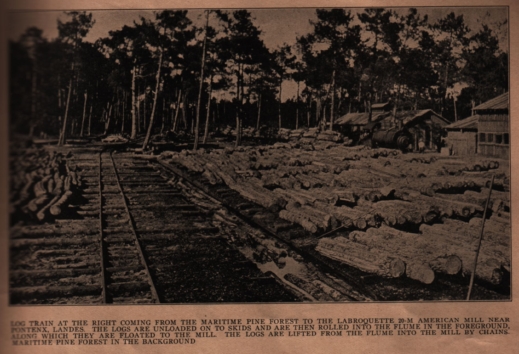
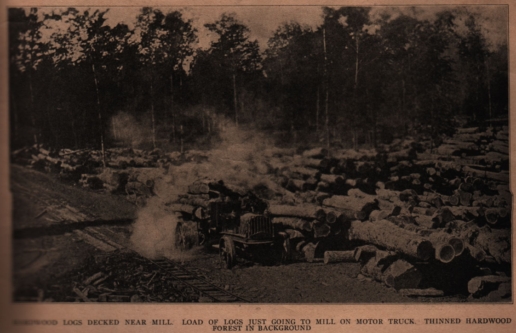
In the spring of 1918 came orders to furnish 15,000 piling in lengths up to 100 feet, with all possible haste. These timbers could not be brought from the United States and were essential to complete the docking facilities required by the rapid increase in the American Expeditionary Force. Again the resourcefulness of the forest engineers was put to the test, for every nook of France had to be scoured for long timbers and practically every tree that was large enough had to be cut--no matter where it stood. The 2d Battalion--up in the Vosges Mountains--covered itself in glory, getting out 9,399 "long and straight" ones faster that the docks could use them. Nor was it a simple trick to get 90 and 100-foot sticks out of the little gullies and down the long, winding roads of the Vosges. The 5th Battalion, meanwhile, was running an express train service with tractors and steel-tired trailers--taking out 80-foot spruce piles over ten miles of French highways. This Battalion furnished over 5,000 piles for the American docks.
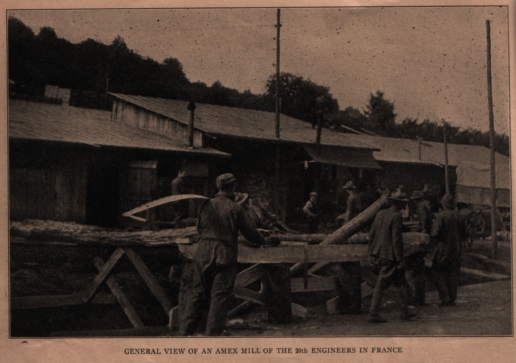
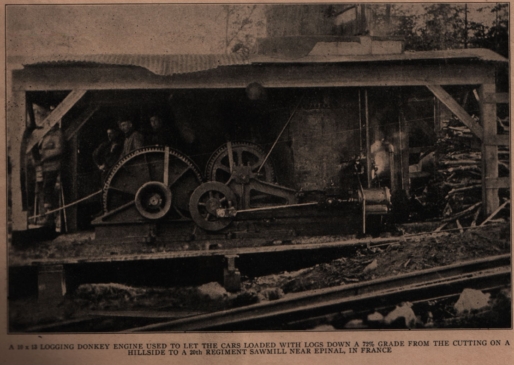
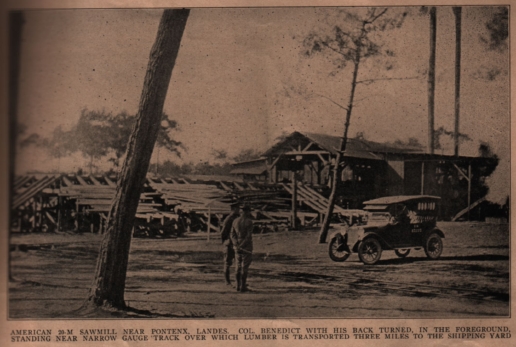
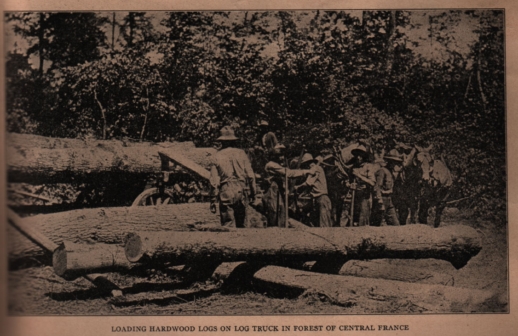
Last December Colonel James A. Woodruff, commanding the 20th Engineers, summed up the work of the twelve thousand odd lumberjacks comprising the regiment in a general order which was a cordial commendation.
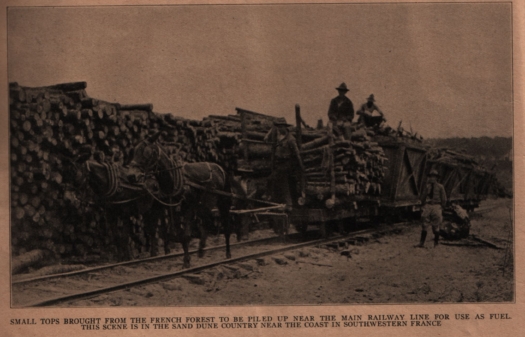
Not all of us were permitted to share in this achievement. With sorrow but with pride the 20th Engineers recall the ninety-one men of the 6th Battalion who won their golden stars on the transport Tuscania. The story is best recorded in the words of an officer of that battalion:
"On the morning of the eighty day out from Halifax, the convoy was met by seven British destroyers, which romped along like porpoises in the heavy seas. With this protection everybody on board felt pretty safe, especially when, on the afternoon of February 5, the shores of Ireland and Scotland hove in sight. But at 5:45 that evening came a bing! bang! With the crash all lights went out, due to the electric plant being put out of commission, and the ship was left in absolute darkness. The men came pouring up onto deck from their quarters, tow or three decks below flares were lighted and everybody set to work lowering the life boars. I many cases, the members of the crew assigned to the bots failed to put in an appearance, and the soldiers, unaccustomed to this work, had to get the boas away as best the could. Some boats were unsuccessfully launched, causing their occupants to be thrown into the icy water. After all available boars and rafts had been launched and two loads of men had been taken off in two British destroyers, which came alongside, 700 men were still left on board with nowhere to go and nohting to do but wait and see what would happen next. No more destroyers seemed inclined to come to the rescue of the ill-fated 700. The Tuscania listed more and more to starboard; the flares burned out, leaving the ship in darkness. The chances of those left on board grew slimmer and slimmer as the icy water crept up closer and closer to the starboard rail. Then, slowly and quietly, ot of the black night a long, black destroyer slipped alongside and, by pumping overboard forty tons of oil, was able to accommodate all those left on the sinking ship."
"During the long wait, one of the companies of the 20th, after seeing comrades drowned in front of them, and not knowing what was in store for themselves, stood in line in perfect order and sang "Where do we go from here, boys? Where do we go from here?"